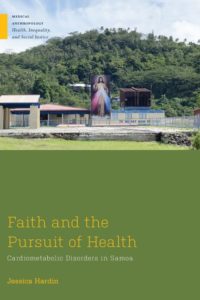Reviewed Book
Faith and the Pursuit of Health: Cardiometabolic Disorders in Samoa. Jessica A. Hardin, New Brunswick, NJ: Rutgers University Press, 2018, 214 pp.

Faith and the Pursuit of Health explores how Pentecostal Christians in Samoa co-conceive religious practice and healing of metabolic disorders, principally Type 2 diabetes and hypertension. These have become endemic among the island nation’s population in the last few decades. The book proposes that Pentecostalism provides a culturally acceptable frame of belief and action that allows Samoans to resolve, to some extent, conflicts that arise between the demands of chronic disease management and the imperatives of locally meaningful social practices around food, fat, and exercise. A second key argument of the book is that both biomedical and mainstream Christian discourses converge on the individual as the site of agency (and therefore responsibility) for obesity and metabolic disorders. But Pentecostalism, a belief system that only became widespread in Samoa in the 1980s, provides a platform for cultural critique of both the rhetoric of individual responsibility and of certain quintessentially Samoan practices, such as giving large gifts to the Church. Pentecostalism’s alternative course of action in the world, Hardin argues, is part of the draw of the religion, especially for people who are diagnosed with cardiometabolic diseases and do not know where to turn.
The book is based on periods of fieldwork spanning four years and over 200 interviews with church leaders and members, people with cardiometabolic diseases, and health care providers and NGO workers in Samoa, American Samoa, Hawai’i, and California. Ethnographically, it centers around practitioners at two Pentecostal churches in Apia, Samoa’s capital city. It consists of an introduction, a conclusion, and six body chapters, each organized around a theme.
Chapter 2 describes setting and methods, while Chapter 3 addresses changing epidemiological landscapes, lifestyles, and foodways distinctive to Samoa that come into conflict with recommendations around diabetes management. Chapter 4 focuses on social hierarchy and ritual exchange in Samoa, and how Pentecostalism claims to renounce those norms in favor of new pathways for seeking personal betterment. Chapter 5 explores how fat can serve as an ambiguous signal—under the right circumstances, indicating robust social networks that involve the unimpeded flow of resources through individuals, but under the wrong circumstances, indicating greed and weak social networks. Chapter 6 addresses how the emphasis on God as the agent of change in Pentecostalism shifts away from the focus on the individual, and Chapter 7 explores social networks—especially religious fellowship in women’s groups—as sources of coping with both cash poverty and cardiometabolic disease. The book concludes with a brief statement about how public health programming in Samoa needs to put religion at the center of their work if it ever hopes to be successful.
Faith and the Pursuit of Health’s greatest strength is how it opens a window onto the structural causes of cardiometabolic diseases through religion—a facet of life that critical medical anthropology often overlooks in its analysis of the structural determinants of health. Hardin’s argument here is a nuanced one. Her claim is not that religion causes cardiometabolic diseases, but rather that some Samoans find religion a useful resource for structuring the social change that will be necessary to address cardiometabolic disorders in its population. She refers to this idea throughout the book as “spiritual etiologies” (p. 9). This pairing of religious practice and the possibility for structural change around cardiometabolic health arises from Hardin’s interlocutors themselves and it is a welcome reminder that the best analysis of complex social phenomena often comes from those embedded therein—another place where critical medical anthropological approaches have often fallen short. The book thus provides a new lens on critical medical anthropology by combining it with the anthropology of religion, as well as an emically grounded, experience-near analysis of two phenomena that prove to be linked in surprising ways: religious conversion and cardiometabolic disorders.
As with most ethnographies, Faith and the Pursuit of Health focuses rather narrowly on one subset of one population: Pentecostal Christians with cardiometabolic disorders. As a result, the book leaves several questions unanswered. Hardin’s central claim that Pentecostalism provides a unique way for Samoans to navigate cardiometabolic disorders would be strengthened by a comparative analysis of non-Pentecostal Christians in Samoa. How do these groups interweave religion and cardiometabolic disorder management? How does this approach look similar to or different from Pentecostals’ approaches? Given Hardin’s long experience in the field, I was surprised to find very little of this comparative discussion in the book. An additional critique is that the book’s conclusion is quite brief, stating in just a few pages that public health programs in Samoa should take religion into account. For applied audiences, such as students and practitioners of public health, it would have been useful to lead readers more deeply through the implications of this important research for policy and programming.
These minor critiques aside, Hardin’s book is a strong case study in how a particular group of people struggles with rapid epidemiological and social change. These are questions that resonate far beyond Hardin’s particular research site to many other corners of the world where epidemiological transitions are producing rapid increases in cardiometabolic disease prevalence. The book is written in a highly accessible, jargon-free style that would be appropriate for undergraduates and graduates alike, including those with no prior background in the anthropology of the Pacific. Faith and the Pursuit of Health is a valuable contribution to our growing understanding of how global economic and social change are shaping health concerns among the world’s most marginalized populations.